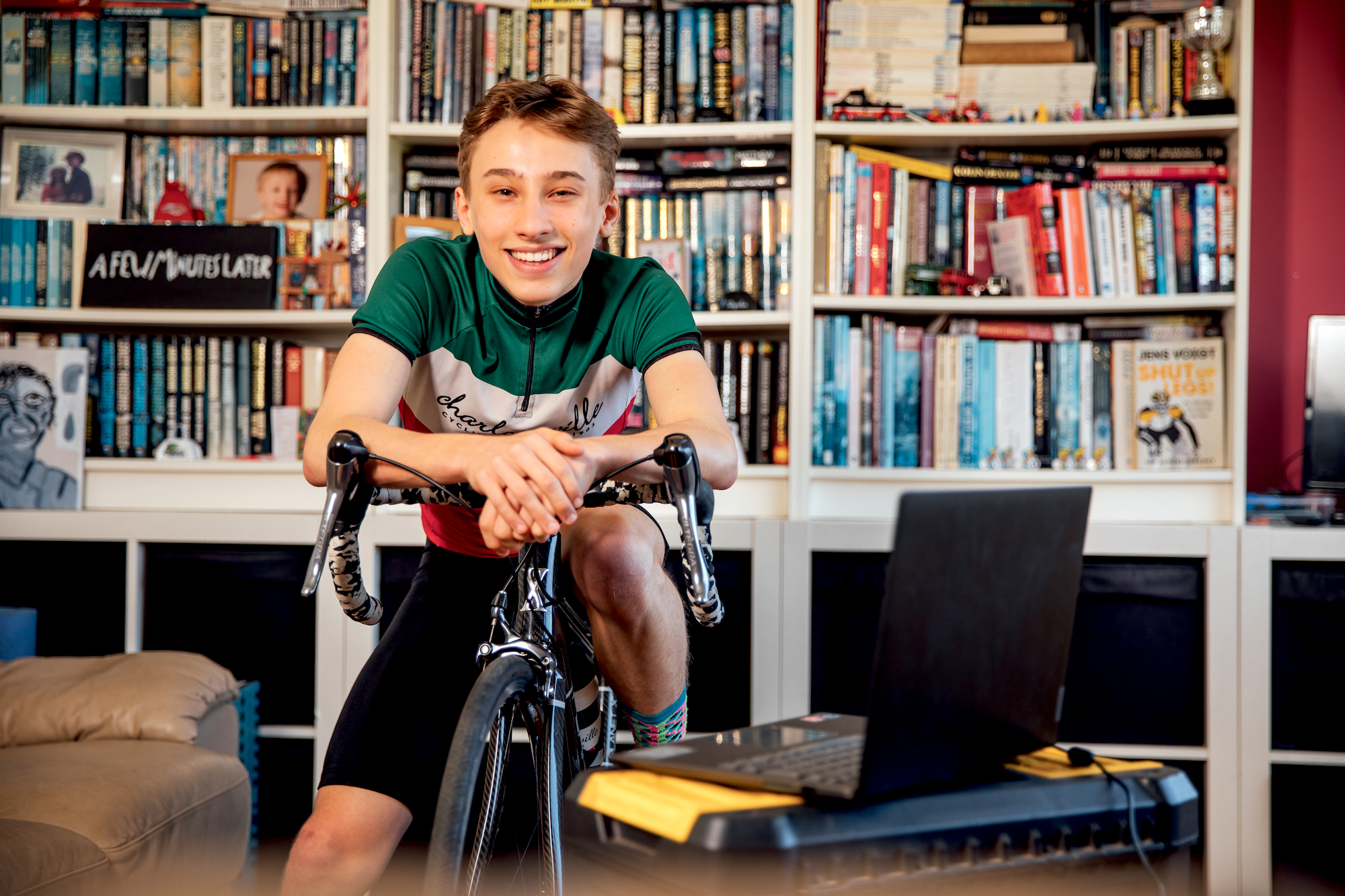'I want to ride in the WorldTour': How British Cycling are using Zwift to help identify young talent
Online training platforms are fast becoming fertile ground for cycling’s talent-spotters. What would it take to make the grade and get noticed on Zwift or Strava? Steve Shrubsall investigates

At just 15 years old, Ben Flatau is aiming for the highest level (Daniel Gould)
The pathway to the top tier of cycling looks like a map of the London Underground. Starting at Club Network, the high-aspiring cyclist will be calling at the Development Centre, the Regional School of Racing, the National School of Racing, the Junior Academy, the Podium Programme and finally fame, glory and a summit finish victory in yellow on Mont Ventoux.
At least that’s how the fairytale traditionally pans out. But how does the talent development system – within British Cycling and more broadly – find the best young riders out there and get them started at their journey’s beginning? And could the virtual world of indoor training and racing on smart-trainers be about to greatly broaden the reach of the talent-spotters?
Among the many elements of its programme – track skills, cyclo-cross, strength and conditioning, rollers sessions, nutritional advice, the list is a long one – BC has recruited the popular virtual cycling app Zwift to help identify talented young riders who have a real chance of cracking the professional cycling scene. Smart trainers provide an easy and effective way to track metrics in a controlled environment, and BC recently ran a pioneering pilot scheme in partnership with Zwift.
CW spoke to BC’s development coach Joe Malik to find out how he is using the ‘game’ to find super-talented 13-16-year-olds.
"It brings people together," said Malik. "The riders who use it may get the opportunity to see each other only four or five times a year, but Zwift has the potential to bring them together more frequently, and the app even allows them to chat to each other."
He is quick to point out that turbo training is just one piece of the pie, and that, in isolation, figures garnered from Zwift will not necessarily book you a place at the next Olympics.
"As a British Cycling programme, using Zwift is about complementing our offer and shouldn’t be taken in isolation. Transferring from a static trainer to riding a bike isn’t always successful – in a bike race, you need to be able to attack, descend and counter-attack."
The latest race content, interviews, features, reviews and expert buying guides, direct to your inbox!
Despite these limitations, Zwift is the perfect platform to establish benchmark figures that can be tracked as young riders grow in size and strength.
"We did three pilot sessions on Zwift," Malik explained. "One was a custom workout – a Russian-steps session – where we looked at peak and average power. At this age [13-16], all types of power are trainable – it can all be developed – so this gives us a good insight into the riders’ potential."
>>> Subscriptions deals for Cycling Weekly magazine
What levels of power was the BC team looking for among all these youth riders?
"From a peak power point of view, anything over 900-1,000 watts for a 15-year-old [boy] is very exciting," said Malik. "Our benchmarks for endurance tests work across three, six and 12 minutes, so we’d look for 350 watts for three minutes as a starting point, and then we’d look to work with the rider to develop that [over six and 12 minutes]."
Cut and thrust
In preparation for this feature, I paid a visit to 15-year-old Ben Flatau at his home in Surrey. Flatau is a youngster already embroiled in the cut and thrust of the talent-ID programme, and that evening he was taking part in one of BC’s talent development races on Zwift.

I watched on as he averaged five watts per kilo – a very strong effort for his 48kg – in the race around Zwift’s virtual version of Central Park. The youngster dismounted onto his living room floor having finished seventh in the bunch sprint, and told me about how he was selected for the programme by his club, Guildford-based Charlotteville CC. He has big dreams about making it to the top.
"You start by going to regional cluster sessions and development pathways, which build up to the RSRs [Regional Schools of Racing]. You also get invited to sessions where you learn about strength and conditioning and nutrition," Flatau told me.
As if his competitive streak needed confirmation after the full-gas virtual sprint he’d just completed, Flatau vividly outlined his ambitions.
"I see myself on one of the academies when I’m 18 or the Podium Programme. After the RSRs, they pick 40 riders from across the country to go on to the Apprentice Programme."
And he has a back-up plan too.
"If that doesn’t turn out in my favour, I know someone who wasn’t accepted onto the programme who, instead of reacting ‘I’m done with cycling’, moved out to Belgium and is now racing with a Belgian team."
>>> Cycling Weekly is available on your Smart phone, tablet and desktop
BC isn’t the first organisation to use Zwift as a form of talent-spotting. The app’s own scheme, the Zwift Academy, gives female Zwifters the chance to compete for a place on the Canyon-SRAM WorldTour team. The under-23 men, meanwhile, are given the opportunity to race for a slot on NTT’s roster. Qualification for the Academy, which takes place every year, comprises a series of workouts and races from which key metrics are extrapolated and eventual winners, male and female, are crowned.
Last year’s female winner and now Canyon-SRAM rider Jess Pratt gave me her view on how online platforms are changing cycling and making it more accessible, since it is easier to demonstrate your talent.
"Zwift allowed me to train safely and efficiently in the early hours of the morning or between night shifts," said Pratt. "I never had an issue finding a training session to suit my goals.
"I look back on Zwift Academy and still pinch myself – very grateful that Zwift and Canyon-SRAM have created the pathway."
Though Pratt has ridden her way to a WorldTour contract, her relationship with Zwift hasn’t ended. "I still incorporate Zwift into my training," she said. "It’s safe, effective and time-efficient. I use it for a range of things, from recovery rides to hard workouts. It allows me to focus on my training session without having to worry about terrain, traffic or weather conditions."
It's clear, then, that riders from all walks of life are using Zwift and other online platforms to train with power in new and engaging ways - particularly during this challenging lockdown period. This in turn providing an opportunity for coaches and talent scouts to glean a great deal of information about new riders' abilities, strengths and weaknesses.
For British Cycling, Zwift is a tool running alongside the development programme - it is not (yet) regarded as a standalone talent-finder. Race-craft and bike-handling are assessed in person, even in cases where a rider's online data is exceptional.
"[In normal times] we do four to five sessions a week," said BC's Malik. "It's a mixture of sessions, a blended approach. We don't just specialise in one discipline for a youngster; we want multi-disciplined athletes."

Road racing and track racing sessions are interspersed with roller, turbo, technical and Zwifting sessions. Having experience on this programme, Ben Flatau confirms that the BC face-to-face sessions are vital for progress: "Most of the cluster sessions are skill-based - lumps and bumps at the track, for example, is a common one, moving straight up and down the track, just to get comfortable moving around. We also do practice races - such as a 20-lap points race - using the skills we've learnt, for example the 'gap rush technique' we've been working on."
There's no avoiding the conclusion that to become a bona fide cyclist with the potential to stand on a WorldTour podium, you're going to need to leave the confines of your garden shed, spare room or garage, and venture into the real world, where you can hone your handling and refine your skills.
Even so - especially given the current situation - testing yourself indoors and tracking those benchmarks can be a powerful motivator. Of course, this doesn't mean hammering yourself in every session - this is absolutely not the time to risk overtraining. But keeping an eye on your data - be it FTP, watts per kilo or short-burst power - as a start point on which to build is certainly very effective. And who knows, you might in time produce pro peloton-worthy levels of performance.
For those with such high ambitions, Elliot Lipski - coach at NTT Pro Cycling and the man who has been tasked to crunch the Zwift Academy figures for the past three seasons - suggests a target power to aim for: "If you're looking to be a pro, FTP of above 5W/kg is a ballpark figure."
As for our young interviewee Flatau, fresh from his promising performance in BC's Zwift pilot event, he's reaching for the stars: "I want to ride in the WorldTour. I enjoy cross so I'd like to ride the Classics, the shorter, punchier races. Roubaix definitely. I've already ridden in the Roubaix velodrome."
Remember the name - and if he's Britain's next big cycling star, you read it here first!
This feature originally appeared in the print edition of Cycling Weekly, on sale in newsagents and supermarkets, priced £3.25.
Steve has been writing (mainly fitness features) for Cycling Weekly for 11 years. His current riding inclination is to go long on gravel bikes... which melds nicely with a love of carbs